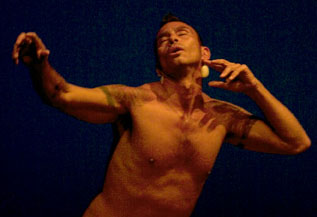|
The University of California/Riverside, and the Ford Foundation, sponsored a "Red Rhythms" conference that mixed and matched an impressive array of traditional Indian dancers with contemporary, ground breaking choreographers. The skilled traditional dancers, and the contemporary indigenous dancers and choreographers, were often one and the same. It was a first time ever event, a powwow of another kind. The conference had everything to do with renewel. Something else was being born; concrete, fresh, imaginative choreography - in one form or another.
The question of authenticity in powwows, and contemporary native dance, was hot on the minds of the scholars - both native and non-native alike - who attended the conference. Talk occurred in ways that were often sensitive, concerned, inclusive, and, when debatable, incisively pitched. Dance events gave the talk immediacy. Authentic, traditional dance was well represented; contemporary dance and choreography added dimension and fresh excitement.
Wichozani Dance Theatre performed on the Arts Quad outside the dance studio. 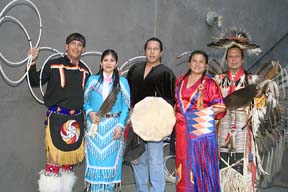 Wichozani, a southern California based Native American theatre company, directed by the award winning fancy dancer, Vincent Whipple (Lakota/Navaho actor, dancer) performs songs, dances, and stories that are "healing for performers, audiences and all people inclusive". California Bear Dancers and Wichozani, a southern California based Native American theatre company, directed by the award winning fancy dancer, Vincent Whipple (Lakota/Navaho actor, dancer) performs songs, dances, and stories that are "healing for performers, audiences and all people inclusive". California Bear Dancers and 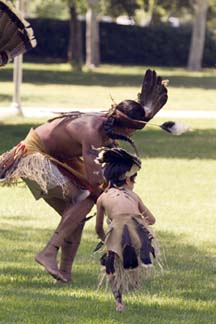 Humaya (hummingbird) dancers , in the "curative tradition with roots in pre-colonial California" performed on the green grass under the trees. Led by Toney Serta, the performers displayed a "strict ritual and ceremonial protocol". These Bear traditions include the practice "centered around the power of Mother Earth symbolic in the presence of the 'mythological powers' of the Bear". The Humaya Dance reflects in a complex liturgy the position of "the human presence in relationship to the rest of the divine environment". Humaya (hummingbird) dancers , in the "curative tradition with roots in pre-colonial California" performed on the green grass under the trees. Led by Toney Serta, the performers displayed a "strict ritual and ceremonial protocol". These Bear traditions include the practice "centered around the power of Mother Earth symbolic in the presence of the 'mythological powers' of the Bear". The Humaya Dance reflects in a complex liturgy the position of "the human presence in relationship to the rest of the divine environment".
The indoor, on-stage performances of the contemporary dancing and choreography were wisely set up at the Riverside Sherman Indian High School. The appreciative hoots and hollars of the teenage students of the school mixed with the quietly absorbed responses of the elders. It was an audience of many colors.
I asked Daystar (Rosalie Jones), the Artistic Director of Daystar: Contemporary Dance-Drama of Indian America, to comment on the choreography. Selections from her recent work, No Home But The Heart, were presented at the conference. No Home But The Heart consolidates dance and the spoken work in a danced drama of her family's journey through 150 years of govermental disruption and repression. Daystar's work, covering a career of forty years, will be archived at the UC-R Library Special Collections. Seven of the contemporary choreographers highlighted at the conference have danced with her.
Daystar:
How can I express to the reader of this article the magnitude of the events of May 5th, 6th and 7th, at the University of California, Riverside? 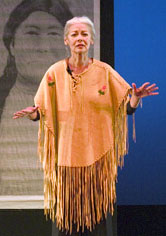 This North American continent, known to its indigenous peoples as "Turtle Island", gave birth in a special way this spring at Riverside, California. The Red Rhythms Conference literally vibrated with new living dances by established and emerging choreographers of native ancestry. This North American continent, known to its indigenous peoples as "Turtle Island", gave birth in a special way this spring at Riverside, California. The Red Rhythms Conference literally vibrated with new living dances by established and emerging choreographers of native ancestry.
It was 1966 when I wrote my Master's thesis in Salt Lake City, pondering the future impact of a professional Native American contemporary dance company in America. Twenty years later, 1980, I founded my company, Daystar: Contemporary Dance Drama of Indian America. It has taken another twenty four years to bear witness to this event inviting native choreographers to network and showcase their work on a national scale in 2004. I cannot adequately applaud the visionary qualities of Jacqueline Shea Murphy, UC-R Professor, and her staff, whose outreach to native dancers in North America made Red Rhythms possible.
Here are the statistics: fifteen dancers performed in eleven works by ten choreographers. These numbers alone would not be of any importance to American modern dance, except that these choreographers are meeting for the "First Time Ever" and they encompass the whole of Turtle Island from the United States to Canada to Hawaii to Mexico to South America.
These choreographers represent a roll call of well known and, to many, unknown aboriginal nations from across North America: Chippewa, Lakota, Ojibway, Bigstone Cree, and Apache. Mohawk and Nahuatl (Aztec) Nations, Isleta and San Juan Pueblos, Mashpee Wampanoag, Pima/Maricopa, Juaneno Band of Mission Indians, Paiute-Shoshone, Tarasco First Nation, as well as those with dual citizenship such as Hawaiian/Blackfoot and Canadian/South American. We would see in the Showcase that the diversity of the choreographers and dancers was matched by the range of their training and dance orientations.
Following the brilliant opening dance of the Apache Mountain Spirit Dancers of Sherman Indian High School, three elegant women took the stage as soloists, affirming the creative role both physical and spiritual, given by the Creator to indigenous women.
Santee Smith, Turtle Clan of the Six Nations in Canada, choreographed and excerpted a solo here from Kaha:wi, an ambitious choreography of the Iroquoian cycle of life from grandmother to mother to daughter.
The full production is premiering in Toronto on the heels of this preview, during the first days of June, 2004.
Geraldine Manossa from Alberta, Canada, danced "Iskwew" (meaning woman in plains Cree language),
a poignant tribute to the numerous indigenous women who recently fell prey to a Vancouver serial killer.
Belinda James of San Juan Pueblo (and New York, long a professional ballet dancer there) stylized within the classical genre, the Messenger Dance (of the tied knots) of the 1680 Pueblo Revolt. 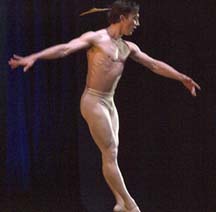 It was performed gallantly by a Ricky Resijan of the New York Theatre Ballet. Note to reader: If you are not familiar with this important indigenous history, you can find it under the subject "Spanish Conquest of New Mexico". It was performed gallantly by a Ricky Resijan of the New York Theatre Ballet. Note to reader: If you are not familiar with this important indigenous history, you can find it under the subject "Spanish Conquest of New Mexico".
Kalani Queypo,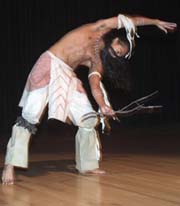 who danced separately at the conference opening event, performed an exquisite solo "Miinigooweziwin - The GIft" , choreographed by Georgina Martinez for the Banff Centre for the Arts and restaged here by Rulan Tangen. who danced separately at the conference opening event, performed an exquisite solo "Miinigooweziwin - The GIft" , choreographed by Georgina Martinez for the Banff Centre for the Arts and restaged here by Rulan Tangen.
"Loss and Endurance", choreographed by Sandra Hughes and performed with Abel Silva, was conceived within the unique mime/mask genre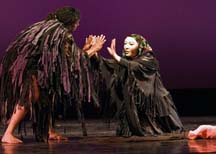 of Gateway Productions. This movingly imaginative work addresses the historical loss to Native American familes of women and infants during childbirth due to the terrible conditions they were forced to endure. of Gateway Productions. This movingly imaginative work addresses the historical loss to Native American familes of women and infants during childbirth due to the terrible conditions they were forced to endure.
Marla Bingham, who danced with Yul Brynner in "The King and I" on Broadway,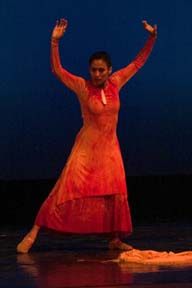 filled the stage with beautiful dancing, describing what can be done in a meeting of contemporary modern and the traditional plains shawl dance style. filled the stage with beautiful dancing, describing what can be done in a meeting of contemporary modern and the traditional plains shawl dance style.
Alejandro Ronceria, noted dance aestheticist, choreographer and company director, choreographed "Agua", inspired by water rituals of indigenous cultures, a work to be premiered outdoors in Toronto this summer at the Harbourfront Centre.
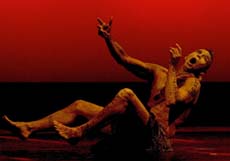 Raoul Trujillo, who hosted the PBS special "America Dancing", continues in the arenas of acting and dancing, and performed the final work of the evening. "Ancestor Dream Machine" An "in the moment" look at native evolution, from earth to human to spirit, through the eyes of the Creator of All. Raoul Trujillo, who hosted the PBS special "America Dancing", continues in the arenas of acting and dancing, and performed the final work of the evening. "Ancestor Dream Machine" An "in the moment" look at native evolution, from earth to human to spirit, through the eyes of the Creator of All.
The mainstay of Red Rhythms Dance Showcase was the amazing Rulan Tangen, who today represents the best of the professional and humanistic aspirations of the emerging contemporary aboriginal dancer/choreographers.
Ms Tangen has gone the route of so many dancers - ballet corp dancer, modern dancer, teacher of young children, solo dancer and choreographer. Now a cancer survivor, she has been given the opportunity to co-direct a new company, Earth Dance Theater, with Andrew Brother Elk of San Francisco. Rulan danced beautifully in an opening solo, "The Naming".
The new company also presented a work in progress, "Thunderstomp" from the larger work Constellations.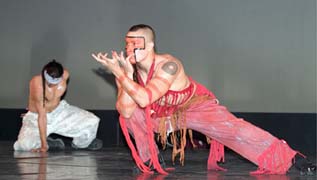 Four street dancers who are being trained also as contemporary dancers, proved they were up to the challenge of the occasion. Four street dancers who are being trained also as contemporary dancers, proved they were up to the challenge of the occasion.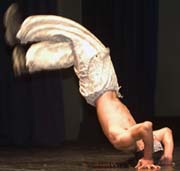
Earlier in the day, Muriel Miguel (original founder of Spiderwoman Theater, NYC) presented "An Evening in Paris", performed in the Dance Studio Theatre. Canadian dancer/actress Michelle Olson delivered a telling personification of Molly Spotted Elk, an early 20th century vaudeville
dancer/actress who, like Josephine Baker, fled the U.S. for Paris, to work. Miguel, having had some contact with a profoundly wounded Spotted Elk during her later years, was grist for the mill of this cautionary tale. The projected double-imaged silhouettes of Molly's stage performance were aptly done by Lina Minifie.
These choreographers and dancers are no fledglings pecking at the outcroppings of the commercial dance scene. They are seasoned, aboriginal professionals who are coming into their own, and into our western world of both commercial and artistic stages. Additional dancers in the Showcase were: Anthony Ch-Wl-Tas Collins, Quetzal Guerrero, Lyle Kochamp, Alejandro Meraz (Thunderstomp); Karen Pheasant, Kateri Walker (No Home But The Heart - Jingle Dancers).
This first-time-ever Red Rhythms Conference and Showcase was not only about a single thrilling performance by ten aboriginal choreographers. It is about the love and sweat of dozens of native dancers struggling to create a contemporary expression that is valid for them and exciting to us. Pay attention, world!. Mother Earth has birthed a new life: aboriginal contemporary dance.
|
